engine JAGUAR XJ 1994 2.G ZF Automatic Transmission Manual
[x] Cancel search | Manufacturer: JAGUAR, Model Year: 1994, Model line: XJ, Model: JAGUAR XJ 1994 2.GPages: 74, PDF Size: 2.66 MB
Page 44 of 74
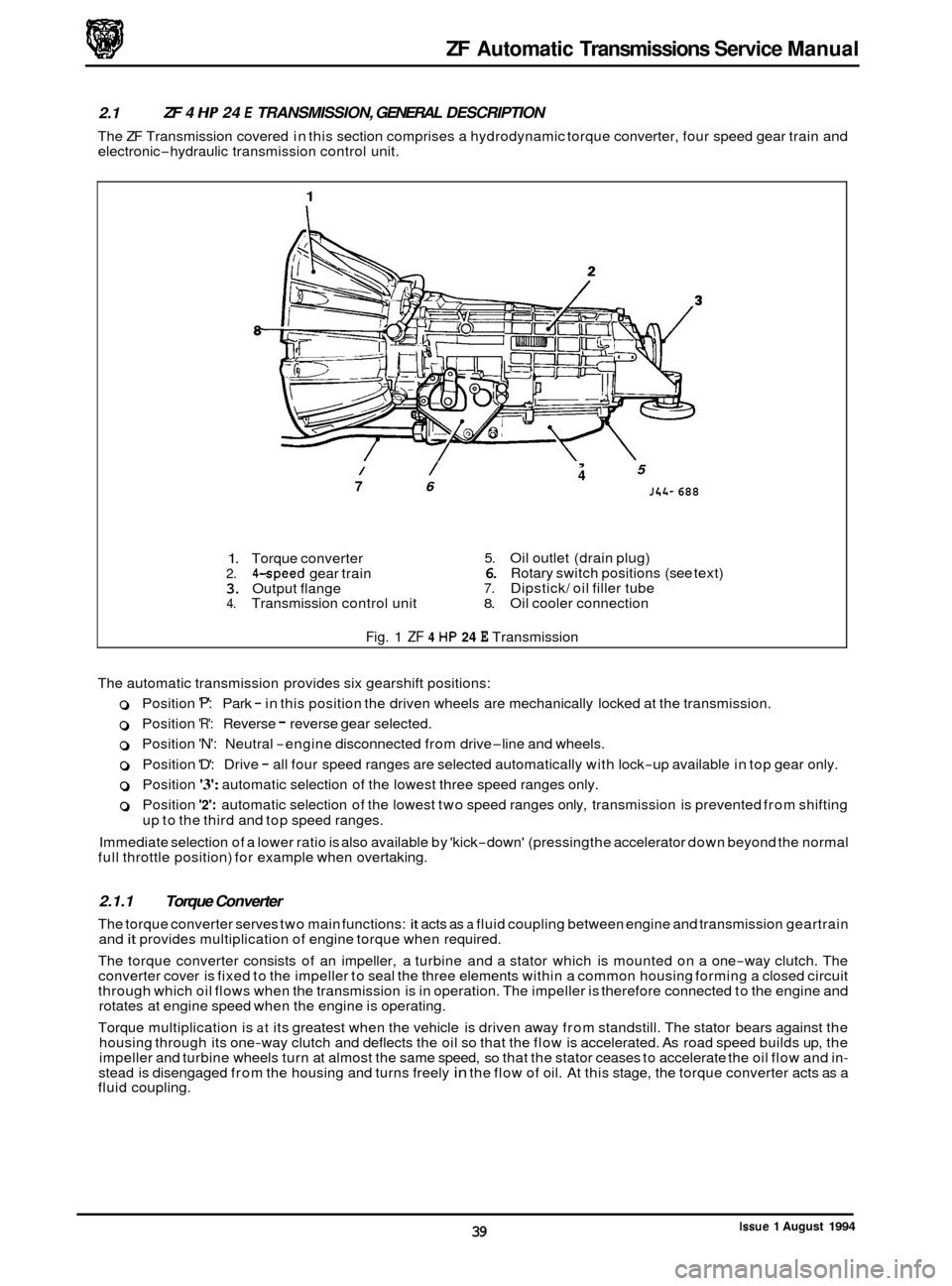
ZF Automatic Transmissions Service Manual
2.1
electronic-hydraulic transmission control unit.
ZF 4 HP 24 E TRANSMISSION, GENERAL DESCRIPTION
The ZF Transmission covered in this section comprises a hydrodynamic torque converter, four speed gear train and
1
/ /
7 6
, 5 4
J4L- 688
1. Torque converter 5. Oil outlet (drain plug)
2. 4-speed gear train 6. Rotary switch positions (see text)
3. Output flange 7. Dipstick/ oil filler tube 4. Transmission control unit 8. Oil cooler connection
Fig. 1 ZF 4 HP 24 E Transmission
The automatic transmission provides six gearshift positions:
0 Position 'P': Park - in this position the driven wheels are mechanically locked at the transmission.
0 Position 'R': Reverse - reverse gear selected.
0 Position 'N': Neutral -engine disconnected from drive-line and wheels.
0 Position 'D': Drive - all four speed ranges are selected automatically with lock-up available in top gear only.
0 Position '3': automatic selection of the lowest three speed ranges only.
0 Position '2': automatic selection of the lowest two speed ranges only, transmission is prevented from shifting
up to the third and top speed ranges.
Immediate selection of a lower ratio is also available by 'kick
-down' (pressing the accelerator down beyond the normal
full throttle position) for example when overtaking.
2.1.1 Torque Converter
The torque converter serves two main functions: it acts as a fluid coupling between engine and transmission geartrain
and it provides multiplication of engine torque when required.
The torque converter consists of an impeller, a turbine and a stator which is mounted on a one
-way clutch. The
converter cover is fixed to the impeller to seal the three elements within a common housing forming a closed circuit
through which oil flows when the transmission is in operation. The impeller is therefore connected to the engine and
rotates at engine speed when the engine is operating.
Torque multiplication is
at its greatest when the vehicle is driven away from standstill. The stator bears against the
housing through its one-way clutch and deflects the oil so that the flow is accelerated. As road speed builds up, the
impeller and turbine wheels turn at almost the same speed, so that the stator ceases to accelerate the oil flow and in- stead is disengaged from the housing and turns freely in the flow of oil. At this stage, the torque converter acts as a
fluid coupling.
Issue 1 August 1994 39
Page 45 of 74
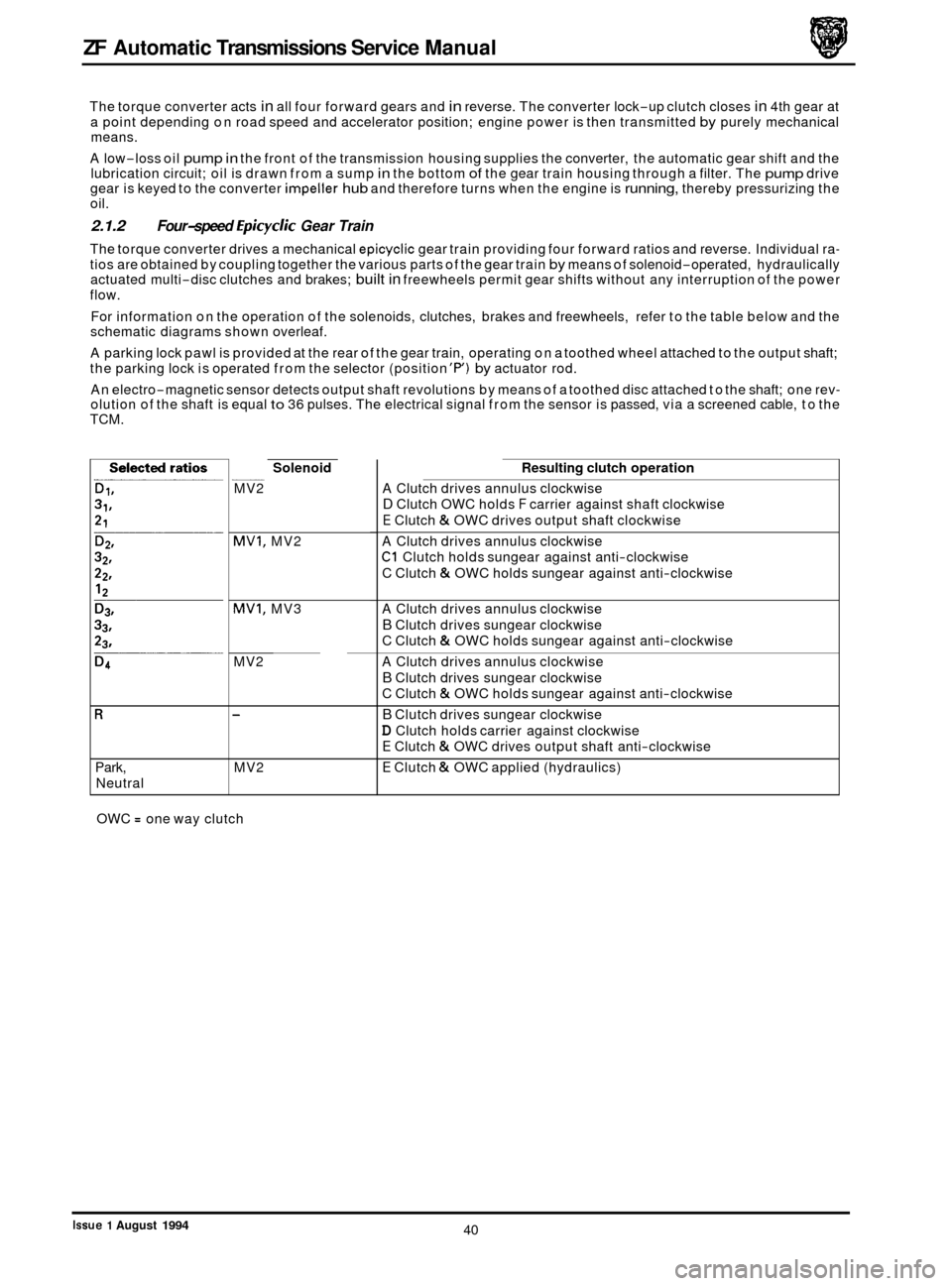
ZF Automatic Transmissions Service Manual
The torque converter acts in all four forward gears and in reverse. The converter lock-up clutch closes in 4th gear at
a point depending on road speed and accelerator position; engine power is then transmitted
by purely mechanical
means.
A low
-loss oil pump in the front of the transmission housing supplies the converter, the automatic gear shift and the
lubrication circuit; oil is drawn from a sump in the bottom of the gear train housing through a filter. The pump drive
gear is keyed to the converter impeller hub and therefore turns when the engine is running, thereby pressurizing the
oil.
2.1.2 Four-speed Epicyclic Gear Train
The torque converter drives a mechanical epicyclic gear train providing four forward ratios and reverse. Individual ra-
tios are obtained by coupling together the various parts of the gear train by means of solenoid-operated, hydraulically
actuated multi-disc clutches and brakes; built in freewheels permit gear shifts without any interruption of the power
flow.
For information on the operation of the solenoids, clutches, brakes and freewheels, refer to the table below and the
schematic diagrams shown overleaf.
A parking lock pawl is provided at the rear of the gear train, operating on a toothed wheel attached to the output shaft;
the parking lock is operated from the selector (position
'P) by actuator rod.
An electro
-magnetic sensor detects output shaft revolutions by means of a toothed disc attached to the shaft; one rev- olution of the shaft is equal to 36 pulses. The electrical signal from the sensor is passed, via a screened cable, to the
TCM.
R
Park,
Neutral
Solenoid ~
MV2
MVI, MV2
MVI, MV3
MV2
-
MV2
OWC
= one way clutch
Resulting clutch operation
A Clutch drives annulus clockwise
D Clutch OWC holds F carrier against shaft clockwise
E Clutch & OWC drives output shaft clockwise
A Clutch drives annulus clockwise
C1 Clutch holds sungear against anti-clockwise
C Clutch
& OWC holds sungear against anti-clockwise
A Clutch drives annulus clockwise
B Clutch drives sungear clockwise
C Clutch
& OWC holds sungear against anti-clockwise
A Clutch drives annulus clockwise
B Clutch drives sungear clockwise
C Clutch
& OWC holds sungear against anti-clockwise
B Clutch drives sungear clockwise
D Clutch holds carrier against clockwise
E Clutch & OWC drives output shaft anti-clockwise
E Clutch & OWC applied (hydraulics)
40
Issue 1 August 1994
Page 46 of 74
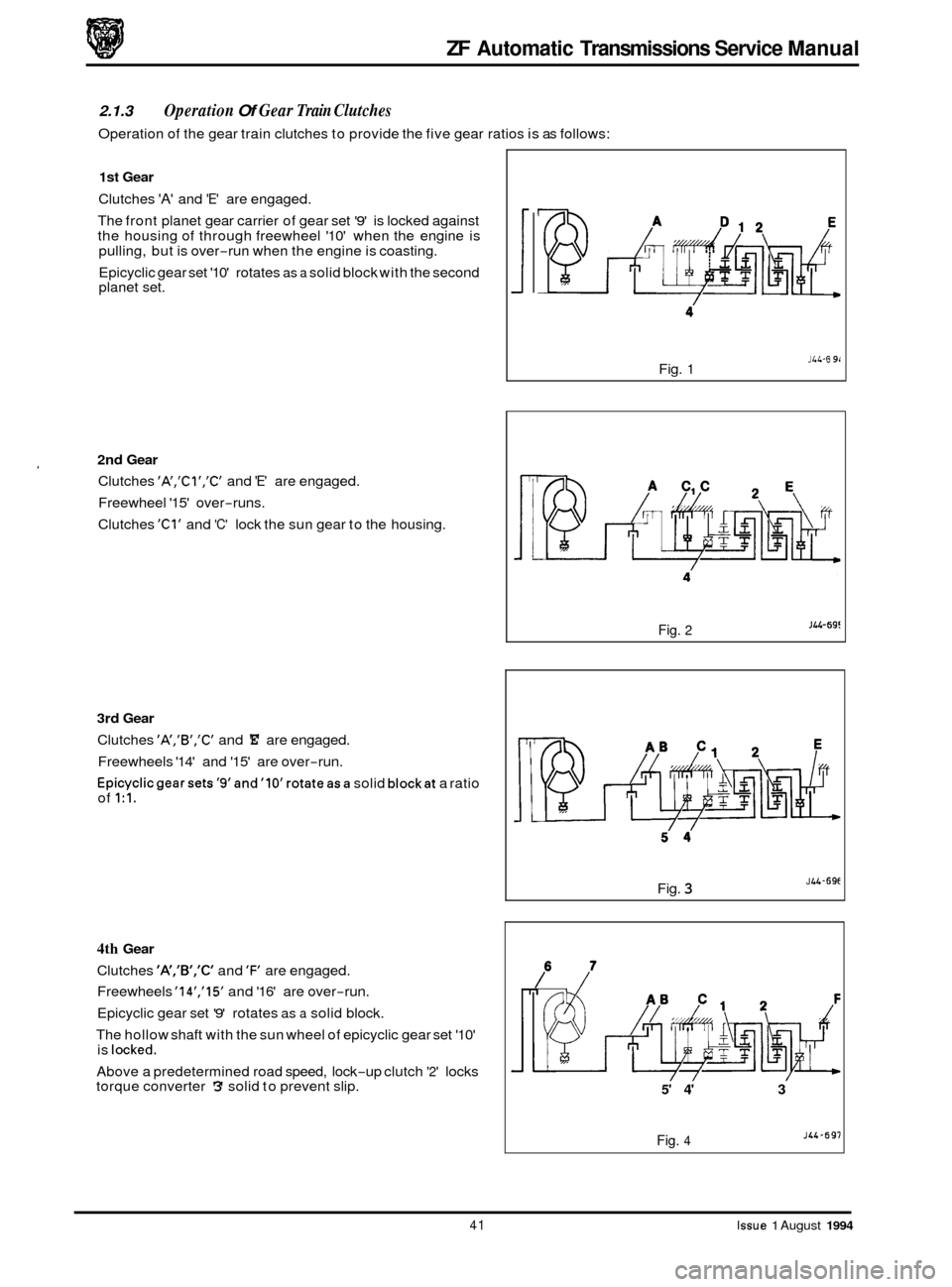
ZF Automatic Transmissions Service Manual
2.1.3 Operation Of Gear Train Clutches
Operation of the gear train clutches to provide the five gear ratios is as follows:
1st Gear
Clutches 'A' and 'E' are engaged.
The front planet gear carrier of gear set
'9' is locked against
the housing of through freewheel '10' when the engine is
pulling, but is over
-run when the engine is coasting.
Epicyclic gear set
'10' rotates as a solid block with the second
planet set.
2nd Gear
Freewheel '15' over-runs.
Clutches
'Cl' and 'C' lock the sun gear to the housing.
* Clutches 'A','Cl','C' and 'E' are engaged.
3rd Gear
Clutches 'A','B','C' and 'E' are engaged.
Freewheels '14' and '15' are over
-run.
Epicyclicgearsets'9'and'lO'rotateasa solid blockat a ratio
of 1:l.
4th Gear
Clutches 'A','B','C' and 'F' are engaged.
Freewheels
'14','15' and '16' are over-run.
Epicyclic gear set
'9' rotates as a solid block.
The hollow shaft with the sun wheel of epicyclic gear set '10'
is
locked.
Above a predetermined road speed, lock-up clutch '2' locks
torque converter '3' solid to prevent slip.
I
J4L-G 9 1 Fig. 1
JLL-69: Fig. 2
J 4L-69E Fig. 3
5' 4' 3
JLL-697 Fig. 4
41 Issue 1 August 1994
Page 47 of 74
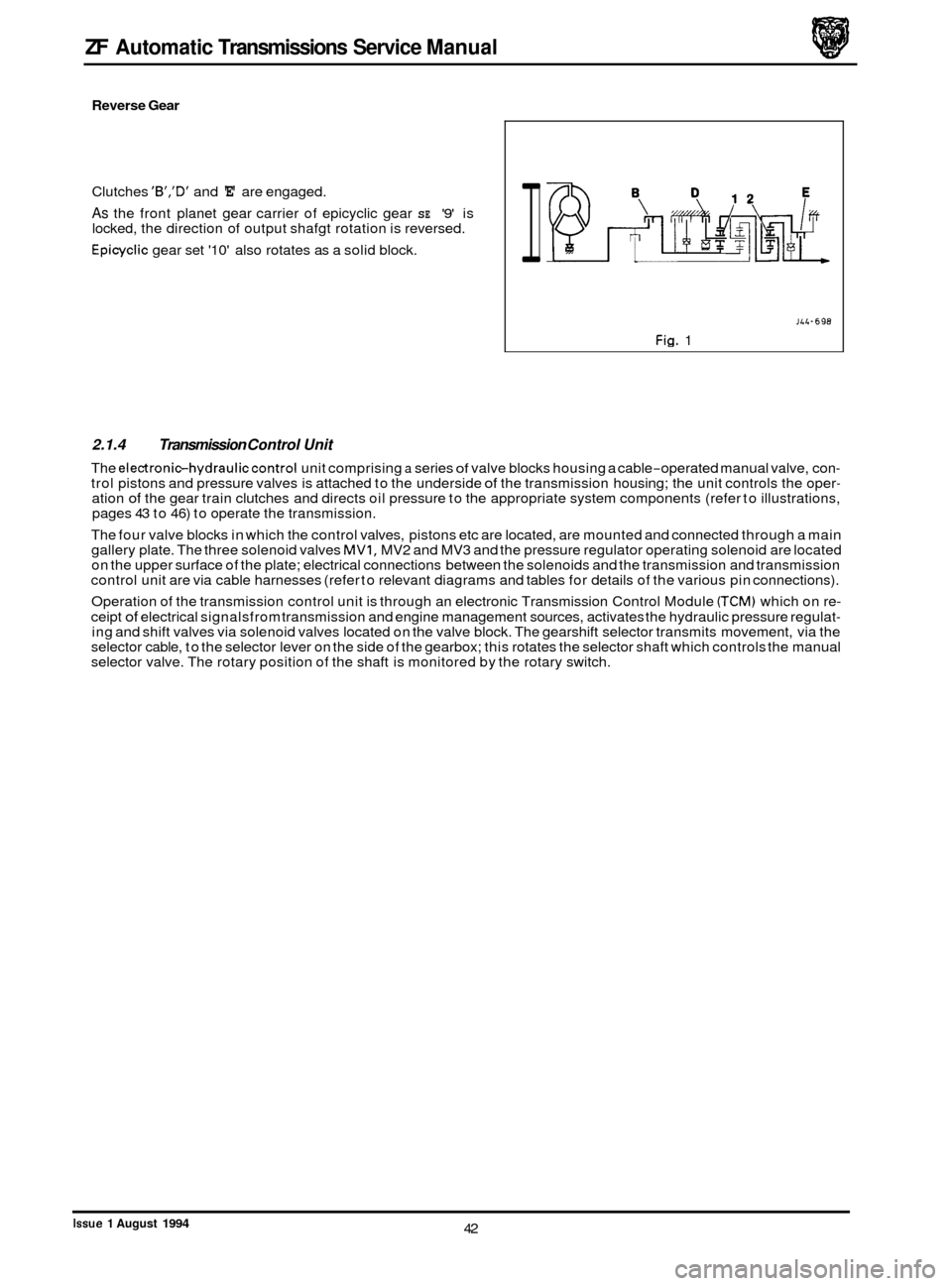
ZF Automatic Transmissions Service Manual
Reverse Gear
Clutches 'B','D' and 'E' are engaged.
As the front planet gear carrier of epicyclic gear SE '9' is
locked, the direction of output shafgt rotation is reversed.
Epicyclic gear set '10' also rotates as a solid block. I
~~~-698
Fig. 1
2.1.4 Transmission Control Unit
The electronichydrauliccontrol unit comprising a series of valve blocks housing a cable-operated manual valve, con- trol pistons and pressure valves is attached to the underside of the transmission housing; the unit controls the oper- ation of the gear train clutches and directs oil pressure to the appropriate system components (refer to illustrations,
pages 43 to 46) to operate the transmission.
The four valve blocks in which the control valves, pistons etc are located, are mounted and connected through a main
gallery plate. The three solenoid valves
MVI, MV2 and MV3 and the pressure regulator operating solenoid are located
on the upper surface of the plate; electrical connections between the solenoids and the transmission and transmission
control unit are via cable harnesses (refer to relevant diagrams and tables for details of the various pin connections).
Operation of the transmission control unit is through an electronic Transmission Control Module
(TCM) which on re-
ceipt of electrical signalsfrom transmission and engine management sources, activates the hydraulic pressure regulat- ing and shift valves via solenoid valves located on the valve block. The gearshift selector transmits movement, via the
selector cable, to the selector lever on the side of the gearbox; this rotates the selector shaft which controls the manual
selector valve. The rotary position of the shaft is monitored by the rotary switch.
42 Issue 1 August 1994
Page 52 of 74

4
AFLR M- -1
4 13 9
14
15 7
J44-718
1.
Selector 2. Mode switch 3. Rotary switch
4. Transmission control unit 5. Output shaft speed sensor 6. Kick-down switch 7. Battery
8. Transmission relay
9.
10.
11.
12.
13.
14.
15.
16.
Transmission control module (TCM)
Reverse lamps
Start inhibiter
Engine speed
Ignition retard
Engine load
Engine control module
(ECM) Engine speed sensor
Fig.
1 Control Layout Schematic
2.1.5 Transmission Control Module (TCM)
The Transmission Control Module (TCM) is an electronic control unit located in the front passenger footwell behind
the underscuttle pad. It is electrically connected to the transmission and other components through a cable harness
and multiple pin plug.
The TCM continuously monitors the gear selected (via the rotary transmission switch), the speed of the output shaft
(by speed sensor on the output shaft) and throttle position ('kick
-down' switch). This information plus input from the
Engine Control Module (ECM) of throttle angle and engine speed and load in conjunction with a pre-programmed con- trol map, enables the most suitable gear to be selected.
The TCM, by operating solenoid valves
MVI, MV2 and MV3, controls the gear shift speed and in conjunction with the
solenoid operated pressure control valve, controls the gear shift quality. Gear shift quality on upshifts is improved by
the TCM momentarily retarding the ignition to reduce the torque input as the gear change takes place. Information
is fed to the TCM from sensors and
if any electronic component fails, the basic shift changes will be performed by the
hydro-mechanical system, ie Park, Reverse, Neutral, D3 or D4.
46
Issue 1 August 1994
Page 53 of 74
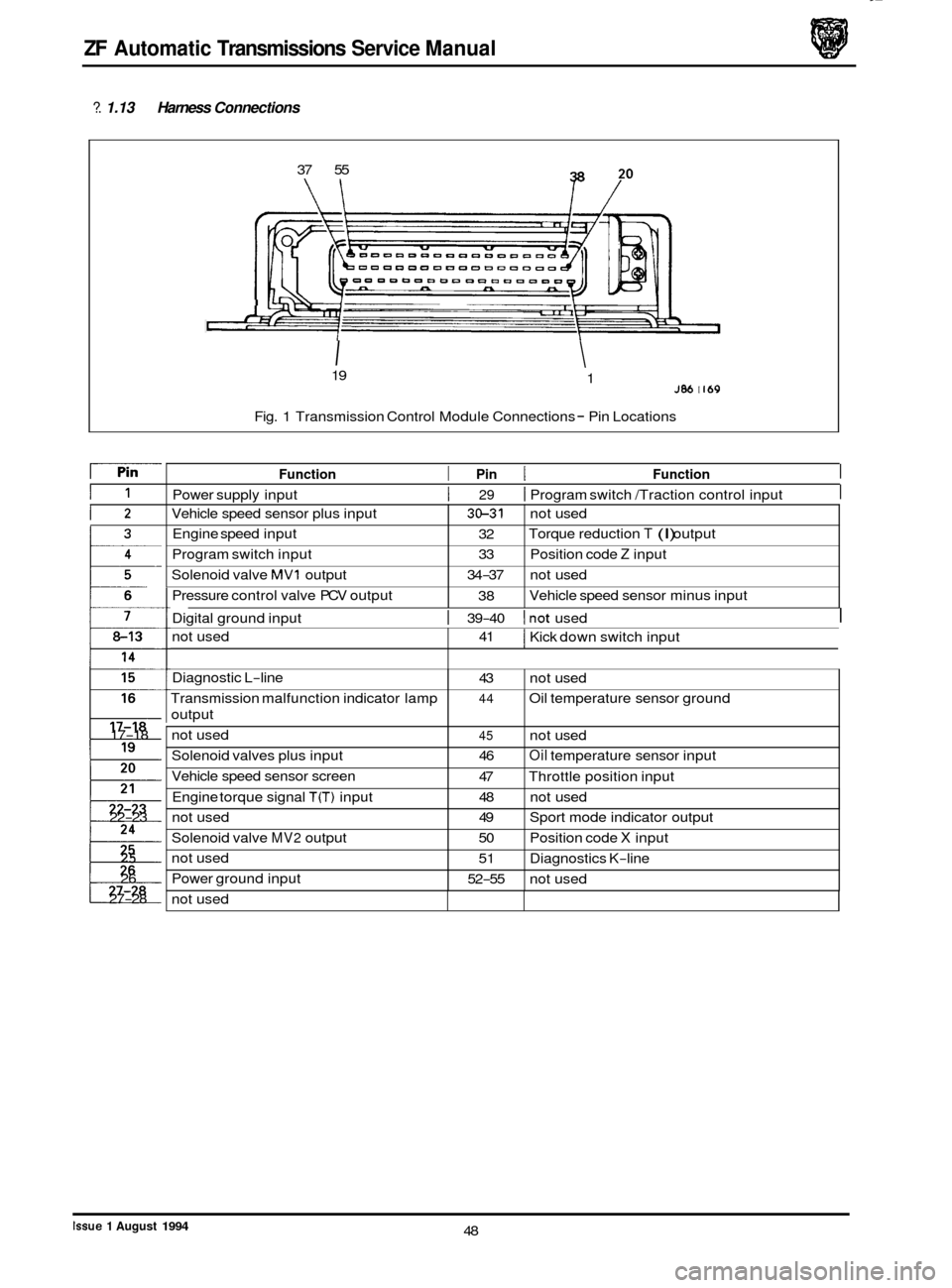
ZF Automatic Transmissions Service Manual
Vehicle speed sensor plus input
Engine speed input
Program switch input
Solenoid valve
MVI output
Pressure control valve PCV output
?. 1.13 Harness Connections
3&31 not used
32
33 Position code
Z input
38 Torque
reduction
T (I) output
34
-37 not used
Vehicle speed sensor minus input
37
55
not used
\I
41 I Kick down switch input
J" i"
Diagnostic L-line
Transmission malfunction indicator lamp
output
not used
Solenoid valves plus input
Vehicle speed sensor screen
Engine torque signal
T(T) input
I IU,MW II
43 not used
44 Oil temperature sensor ground
45 not used
46
Oil temperature sensor input
47 Throttle position input
48 not used
I
not used
Solenoid valve
MV2 output
not used
Power ground input 19
49 Sport mode indicator output
50 Position code X input
51 Diagnostics K
-line
52
-55 not used
J86 I I69 1
Fig.
1 Transmission Control Module Connections - Pin Locations
I1
12
13
: I
17-18
22
-23
t 27-28
25
26
Function I Pin I Function I
Power supply input I 29 I Program switch /Traction control input I
Digital ground input I 39-40 lnot used I
not used
-~
48 Issue 1 August 1994
Page 56 of 74
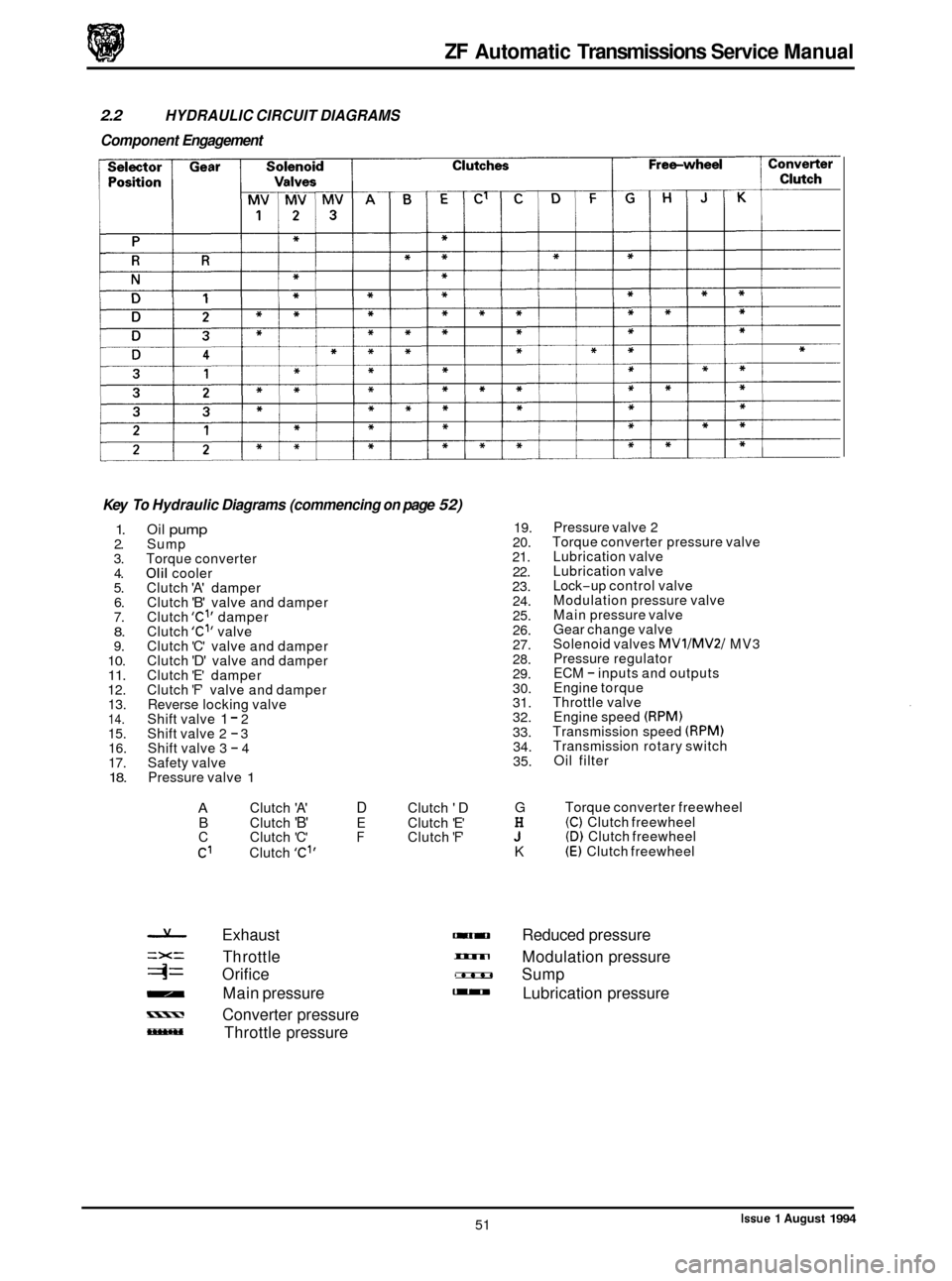
ZF Automatic Transmissions Service Manual
2.2 HYDRAULIC CIRCUIT DIAGRAMS
Component Engagement
Key
To Hydraulic Diagrams (commencing on page 52)
1. 2.
3. 4.
5. 6.
7.
8. 9. 10. 11. 12. 13.
14. 15. 16.
17.
18.
Oil pump Sump
Torque converter
Olil cooler
Clutch 'A' damper
Clutch 'B' valve and damper
Clutch 'Cl' damper
Clutch 'Cl' valve
Clutch 'C' valve and damper
Clutch
'D' valve and damper
Clutch 'E' damper
Clutch
'F' valve and damper
Reverse locking valve
Shift valve
1 - 2
Shift valve 2 - 3
Shift valve 3 - 4
Safety valve
Pressure valve
1
A Clutch 'A' D Clutch 'D B Clutch 'B' E Clutch 'E'
C Clutch 'C' F Clutch 'F'
C1 Clutch 'C"
19.
20.
21.
22.
23. 24.
25.
26.
27.
28.
29.
30.
31.
32.
33. 34.
35.
G
H J K
Pressure valve 2
Torque converter pressure valve
Lubrication valve
Lubrication valve
Lock
-up control valve
Modulation pressure valve
Main pressure valve
Gear change valve
Solenoid valves
MVllMV2l MV3
Pressure regulator
ECM
- inputs and outputs
Engine torque
Throttle valve Engine speed
(RPM) Transmission speed (RPM) Transmission rotary switch
Oil filter
Torque converter freewheel
(C) Clutch freewheel (D) Clutch freewheel (E) Clutch freewheel
Exhaust - Reduced pressure
=X= Th rott le - Modulation pressure
4= Orifice 2- Sump
- Main pressure - Lubrication pressure
- Converter pressure
Throttle pressure
Issue 1 August 1994 51
Page 65 of 74
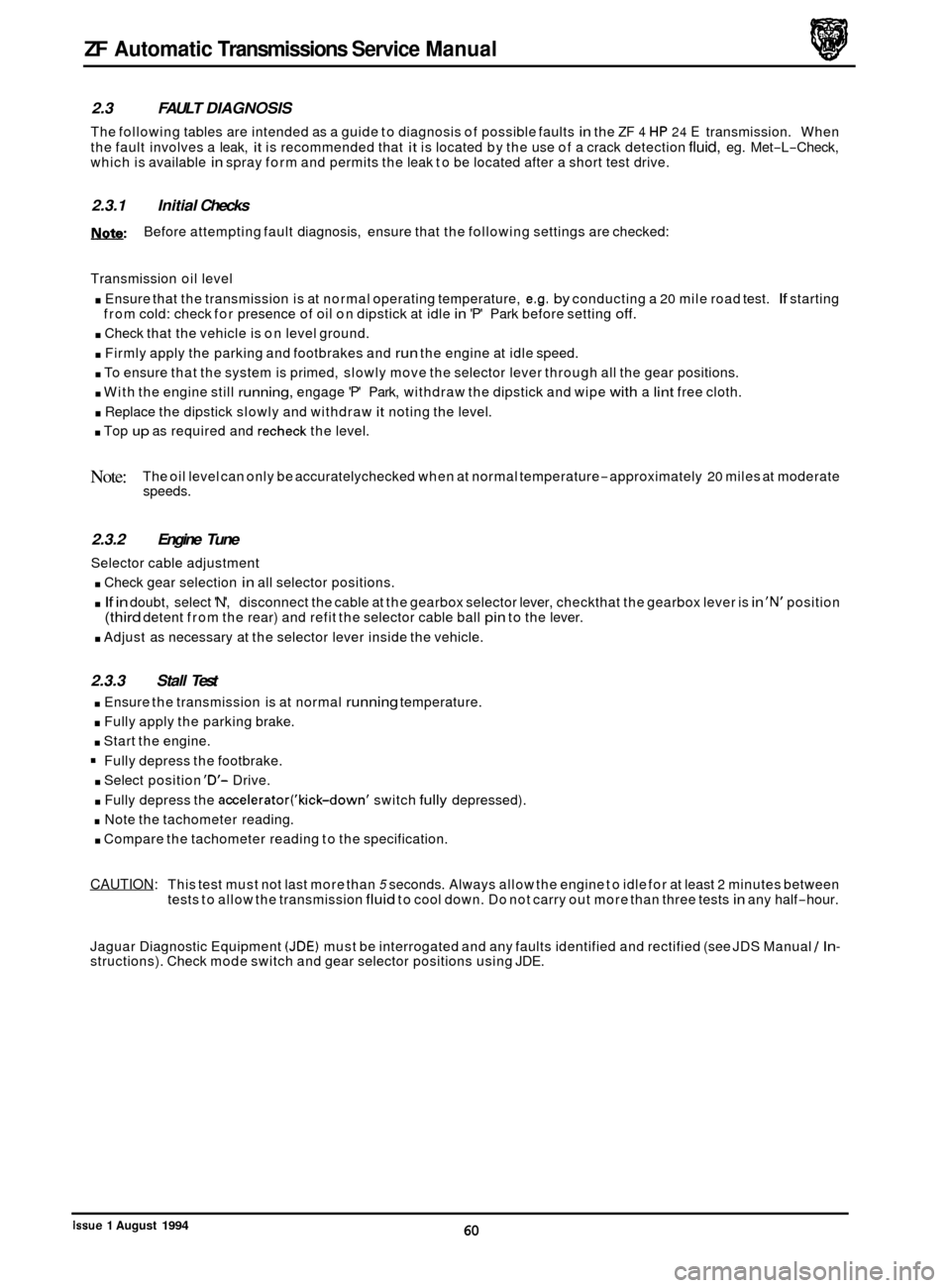
ZF Automatic Transmissions Service Manual
0
2.3 FAULT DIAGNOSIS
The following tables are intended as a guide to diagnosis of possible faults in the ZF 4 HP 24 E transmission. When
the fault involves a leak,
it is recommended that it is located by the use of a crack detection fluid, eg. Met-L-Check,
which is available in spray form and permits the leak to be located after a short test drive.
2.3.1 Initial Checks
&@: Before attempting fault diagnosis, ensure that the following settings are checked:
Transmission oil level
. Ensure that the transmission is at normal operating temperature, e.g. by conducting a 20 mile road test. If starting
. Check that the vehicle is on level ground.
. Firmly apply the parking and footbrakes and run the engine at idle speed.
. To ensure that the system is primed, slowly move the selector lever through all the gear positions.
. With the engine still running, engage 'P' Park, withdraw the dipstick and wipe with a lint free cloth.
. Replace the dipstick slowly and withdraw it noting the level.
. Top up as required and recheck the level.
from
cold: check for presence of
oil on dipstick at idle in 'P' Park before setting off.
Note: The oil level can only be accuratelychecked when at normal temperature-approximately 20 miles at moderate
speeds.
2.3.2 Engine Tune
Selector cable adjustment
. Check gear selection in all selector positions.
. If in doubt, select 'N', disconnect the cable at the gearbox selector lever, checkthat the gearbox lever is in 'N' position
. Adjust as necessary at the selector lever inside the vehicle.
(third detent from the rear) and refit the selector cable ball pin to the lever.
2.3.3 Stall Test
. Ensure the transmission is at normal running temperature.
. Fully apply the parking brake.
. Start the engine.
= Fully depress the footbrake.
. Select position 'D'- Drive.
. Fully depress the accelerator('kick-down' switch fully depressed).
. Note the tachometer reading.
. Compare the tachometer reading to the specification.
CAUTION: This test must not last more than 5 seconds. Always allow the engine to idle for at least 2 minutes between
tests to allow the transmission fluid to cool down. Do not carry out more than three tests in any half-hour.
Jaguar Diagnostic Equipment
(JDE) must be interrogated and any faults identified and rectified (see JDS Manual / In- structions). Check mode switch and gear selector positions using JDE.
60 Issue 1 August 1994
Page 66 of 74
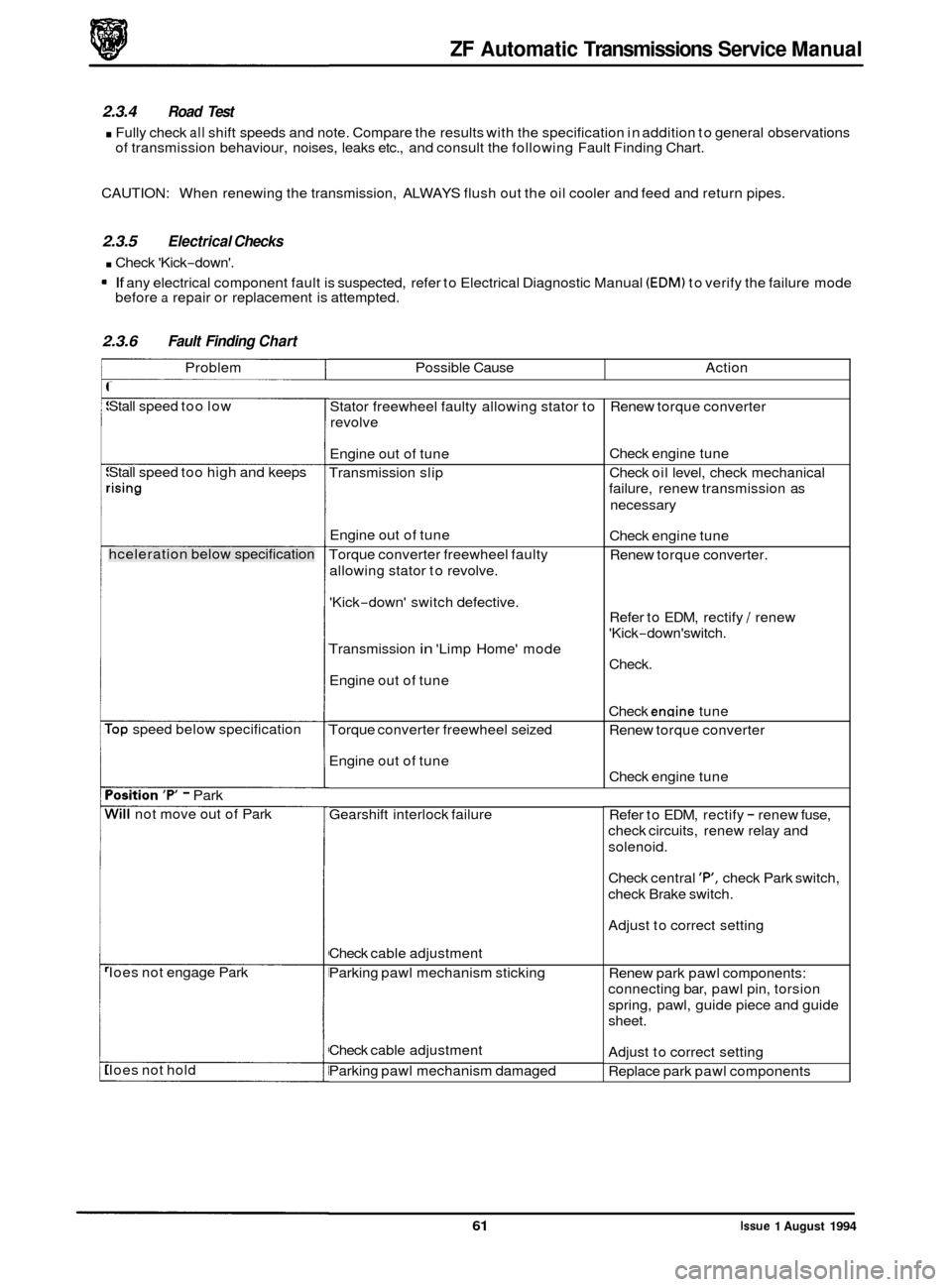
ZF Automatic Transmissions Service Manual
Problem Possible Cause
2.3.4 Road Test
. Fully check all shift speeds and note. Compare the results with the specification in addition to general observations of transmission behaviour, noises, leaks etc., and consult the following Fault Finding Chart.
Action
CAUTION:
When renewing the transmission, ALWAYS flush out the oil cooler and feed and return pipes.
2.3.5 Electrical Checks
. Check 'Kick-down'.
If any electrical component fault is suspected, refer to Electrical Diagnostic Manual (EDM) to verify the failure mode
before a repair or replacement is attempted.
2.3.6 Fault Finding Chart
Stall speed too low
Stall speed too high and keeps
,ising
hceleration below specification
Top speed below specification
'osition 'P - Park
Nil1 not move out of Park
Ioes not engage Park
Ioes not hold Stator
freewheel faulty allowing stator to
revolve
Engine out of tune
Transmission slip
Engine out of tune
Torque converter freewheel faulty
allowing stator to revolve.
'Kick
-down' switch defective.
Transmission
in 'Limp Home' mode
Engine out of tune
Torque converter freewheel seized
Engine out of tune
Gearshift interlock failure
Check cable adjustment
Parking pawl mechanism sticking
Check cable adjustment
Parking pawl mechanism damaged Renew
torque converter
Check engine tune
Check oil level, check mechanical
failure, renew transmission as
necessary
Check engine tune
Renew torque converter.
Refer to EDM, rectify
I renew
'Kick
-down'switch.
Check.
Check
engine tune
Renew torque converter
Check engine tune
Refer to EDM, rectify
- renew fuse,
check circuits, renew relay and
solenoid.
Check central
'P, check Park switch,
check Brake switch.
Adjust to correct setting
Renew park pawl components:
connecting bar, pawl pin, torsion
spring, pawl, guide piece and guide
sheet.
Adjust to correct setting
Replace park pawl components
61 Issue 1 August 1994
Page 67 of 74
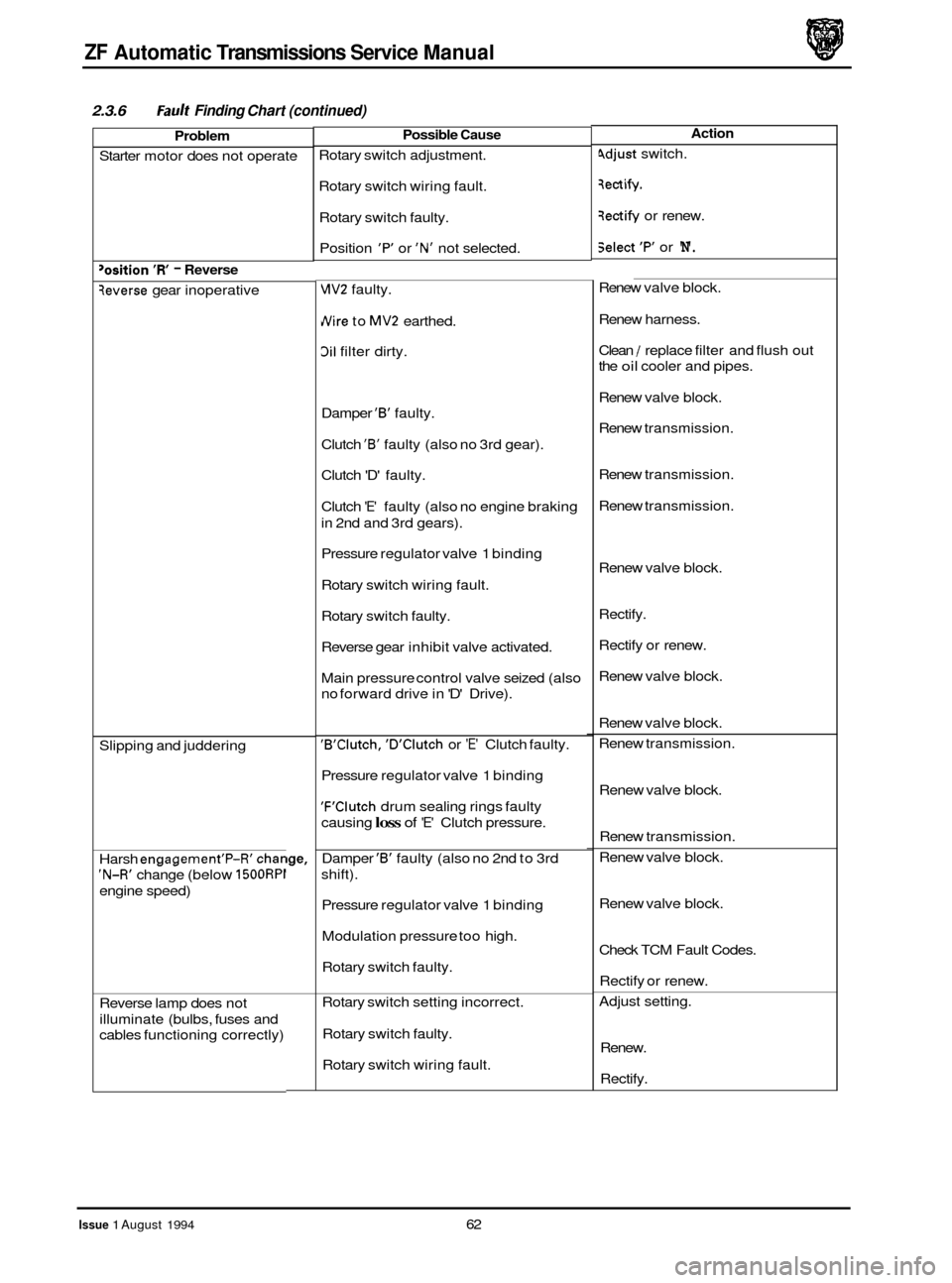
ZF Automatic Transmissions Service Manual
a
2.3.6 Fault Finding Chart (continued)
Problem
Starter motor does not operate
'osition 'R' - Reverse
3everse gear inoperative
Slipping and juddering
Harsh
engagement'p-R' chan
'N-R' change (below 1500RPF
engine speed)
Reverse lamp does not
illuminate (bulbs, fuses and
cables functioning correctly)
Possible Cause
Rotary switch adjustment.
Rotary switch wiring fault.
Rotary switch faulty.
Position
'P or 'N' not selected.
vIV2 faulty.
rNire to MV2 earthed.
3il filter dirty.
Damper
'6' faulty.
Clutch
'6' faulty (also no 3rd gear).
Clutch 'D' faulty.
Clutch
'E' faulty (also no engine braking
in 2nd and 3rd gears).
Pressure regulator valve 1 binding
Rotary switch wiring fault.
Rotary switch faulty.
Reverse gear inhibit valve activated.
Main pressure control valve seized (also
no forward drive in 'D' Drive).
'B'Clutch, 'D'Clutch or 'E' Clutch faulty.
Pressure regulator valve 1 binding
'F'Clutch drum sealing rings faulty
causing
loss of 'E' Clutch pressure.
Damper
'6' faulty (also no 2nd to 3rd
shift).
Pressure regulator valve 1 binding
Modulation pressure too high.
Rotary switch faulty.
Rotary switch setting incorrect.
Rotary switch faulty.
Rotary switch wiring fault.
Action
4djust switch.
qectify.
3ectify or renew.
Select 'F" or 'N'.
Renew valve block.
Renew harness.
Clean
/ replace filter and flush out
the
oil cooler and pipes.
Renew valve block.
Renew transmission.
Renew transmission.
Renew transmission.
Renew valve block.
Rectify.
Rectify or renew.
Renew valve block.
Renew valve block.
Renew transmission.
Renew valve block.
Renew transmission.
Renew valve block.
Renew valve block.
Check TCM Fault Codes.
Rectify or renew.
Adjust setting.
Renew.
Rectify.
Issue 1 August 1994 62